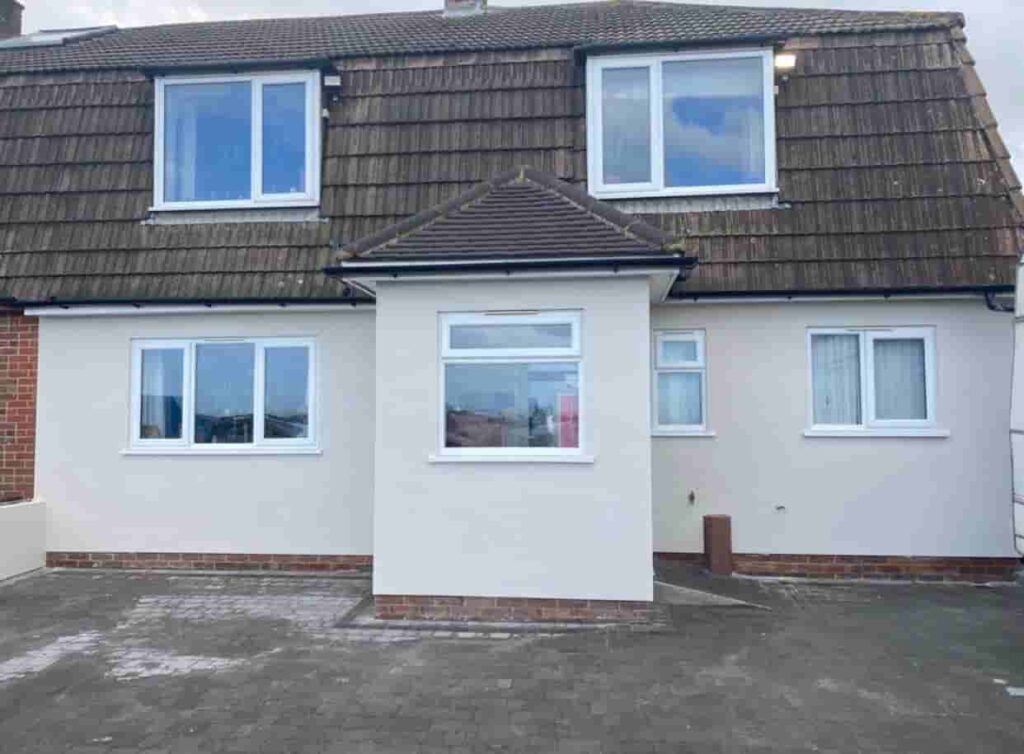Gable end walls are a defining feature of many traditional British homes, providing both aesthetic appeal and structural strength. However, when cracks start to appear in a gable end, they should never be ignored. What begins as a small fissure can quickly become a sign of more serious structural movement or weather-related damage. At Alfreton Roofing Repairs, we frequently inspect and repair gable end walls throughout Alfreton, Nottinghamshire, helping property owners safeguard their homes from costly deterioration and potential collapse.
Understanding the Role of Gable End Walls
A gable end wall forms the triangular section of a wall between the edges of a pitched roof. It supports part of the roof structure and shields the interior from wind and rain. Because of its exposure and positioning, the gable end is particularly vulnerable to damage from weather, structural movement, and inadequate maintenance.
When cracks appear, they often indicate stress within the wall or the roof structure above it. Left untreated, these cracks can expand and compromise both the appearance and stability of your property.
Common Causes of Gable End Cracking
Cracks in a gable end wall can develop for various reasons, from age-related wear to environmental factors. Understanding these causes helps homeowners identify problems early before they escalate into more serious damage.
1. Roof Spread and Structural Movement
One of the most common causes of gable end cracking is roof spread. This occurs when the roof timbers begin to push outward due to movement, decay, or weakened ties. Over time, the outward pressure can force the gable wall to lean or crack near the apex.
2. Poor or Deteriorating Brickwork
Older properties in Alfreton often feature traditional brick or stone gable ends. Over time, mortar joints can erode due to frost, moisture, or natural ageing. This deterioration weakens the structure, allowing cracks to form and widen with each freeze-thaw cycle.
3. Water Ingress and Freeze-Thaw Damage
When water seeps into small cracks or porous bricks, it expands as it freezes, forcing the gaps wider. Repeated freeze-thaw action during the winter months can lead to significant cracking and even displacement of masonry.
4. Wind Pressure and Exposure
Gable ends are often the most exposed part of a building, bearing the full force of high winds. In areas like Alfreton, where storms and strong gusts are not uncommon, prolonged wind pressure can cause structural strain, especially in poorly maintained or weakened walls.
5. Foundation Movement or Subsidence
If the ground beneath the property shifts or settles unevenly, the resulting movement can manifest as diagonal cracks in the gable end. These may appear near the corners or run vertically from the top of the wall downwards.
6. Inadequate Roof Ties or Wall Restraints
In many older homes, the roof structure relies on metal wall ties or restraints to keep the gable end secure. Over time, these ties can corrode or fail, allowing the wall to bow outward, eventually leading to cracking and potential collapse.
Warning Signs to Look Out For
Early detection is key to preventing serious structural issues. Property owners should regularly inspect their gable ends for the following warning signs:
- Diagonal or stepped cracks running through brick or mortar joints.
- Gaps forming between the gable wall and roofline.
- Loose or displaced bricks near the apex of the wall.
- Visible bulging or leaning of the gable wall.
- Cracks visible inside the loft area near the roof timbers.
If any of these signs are present, professional assessment from Alfreton Roofing Repairs is essential to determine the extent of the damage and prevent further deterioration.
How to Prevent Gable End Damage
Prevention begins with regular inspections and timely maintenance. A proactive approach can extend the life of your roof and prevent the costly consequences of structural failure.
1. Regular Roof and Gable Inspections
A professional inspection can detect early signs of damage or movement before they become serious. It’s particularly important after storms, high winds, or harsh winters when brickwork and mortar are most at risk.
2. Ensure Proper Roof Support
Roof timbers, ties, and restraints should be checked periodically to ensure they are functioning as intended. Reinforcing or replacing weakened ties helps to maintain structural integrity and prevent outward roof spread.
3. Maintain Brickwork and Mortar
Repointing deteriorated mortar joints helps to strengthen the gable end wall and seal it against moisture. Using appropriate materials ensures flexibility and durability in varying weather conditions.
4. Improve Drainage and Water Protection
Blocked or damaged gutters can allow water to cascade down gable walls, accelerating brick and mortar decay. Ensuring effective roof drainage prevents moisture from penetrating the structure.
5. Address Vegetation Growth
Climbing plants or moss on the gable wall can trap moisture against the surface. Regular cleaning and vegetation control prevent unnecessary dampness and potential brick erosion.
The Importance of Timely Repairs
Once cracks appear, acting quickly can prevent more serious damage. Small gaps can usually be repointed or filled, but larger or spreading cracks often indicate underlying movement. In such cases, reinforcement or partial rebuilding may be necessary to restore structural stability.
At Alfreton Roofing Repairs, we assess every gable end carefully to determine whether the problem stems from roof spread, water damage, or foundation movement. Our experienced team then applies appropriate repairs to ensure lasting safety and protection.
Reinforcing the Gable End Structure
In some situations, reinforcement is required to prevent collapse or further cracking. Professional roofers can install additional wall ties, anchors, or braces to stabilise the gable end. These measures not only secure the wall but also prevent future movement caused by the roof structure or weather exposure.
Properly installed reinforcement provides long-term security, maintaining the balance between your roof and walls and ensuring your property remains safe and structurally sound.
Why Professional Expertise Matters
Repairing a cracked or leaning gable end requires more than just filling gaps—it demands a clear understanding of how the roof and wall structures interact. At Alfreton Roofing Repairs, we combine skilled craftsmanship with technical knowledge to address the root cause of the problem, not just the visible symptoms.
Our team uses proven repair methods, quality materials, and precise workmanship to restore the integrity of your gable end. Whether it’s re-pointing, reinforcement, or roofline adjustment, every task is carried out with attention to detail and long-term durability in mind.
Conclusion
Gable end cracking is more than a cosmetic issue—it’s often an early sign of structural strain that, if ignored, could lead to partial or complete wall collapse. Weather exposure, roof movement, and ageing materials all contribute to this common problem, but with regular maintenance and professional care, it can be prevented. For homeowners in Alfreton, Nottinghamshire, Alfreton Roofing Repairs provides expert inspections, repairs, and reinforcements designed to protect your property, ensuring your gable end remains strong, secure, and resilient for years to come.
Call us on: 01773 304 893
Click here to find out more about Alfreton Roofing Repairs
Click here to complete our contact form and see how we can help with your roofing needs.

